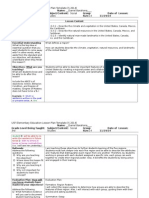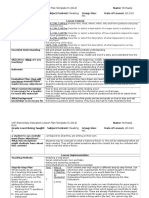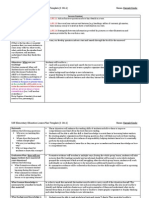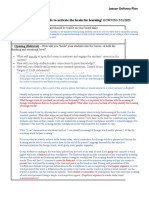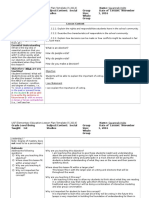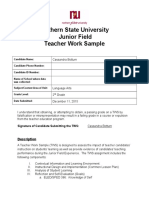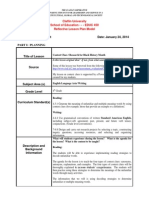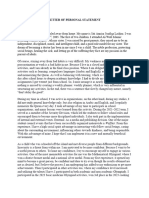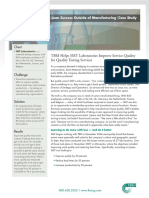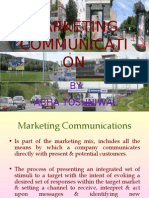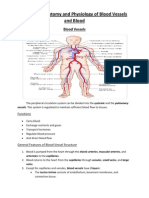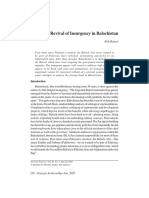Ede4944 Ct1lessonplan
Ede4944 Ct1lessonplan
Uploaded by
api-297176782Copyright:
Available Formats
Ede4944 Ct1lessonplan
Ede4944 Ct1lessonplan
Uploaded by
api-297176782Original Title
Copyright
Available Formats
Share this document
Did you find this document useful?
Is this content inappropriate?
Copyright:
Available Formats
Ede4944 Ct1lessonplan
Ede4944 Ct1lessonplan
Uploaded by
api-297176782Copyright:
Available Formats
USF Elementary Education Lesson Plan Template (S 2014)
What Standards (national
or state) relate to this
lesson?
(You should include ALL
applicable standards. Rarely
do teachers use just one:
theyd never get through
them all.)
Name: Amanda Silebi
Lesson Content
LACC1.RI.1.1 Ask and answer questions about key details
LACC.1.RI.2.6 Distinguish between information provided by pictures and words
LACC.1.RI.4.10 Read informational texts
LACC.1.W.3.8 Recall information from experiences or gather information from sources to
answer a question
LACC.1.SL.1.1.a Follow rules for discussions
LACC.1.5.SL.2.5 Add drawings or visual displays to descriptions to clarify ideas, thoughts,
and feelings
SC.1.N.1.1 Raise questions about/investigate/explain natural world
Essential Understanding
(What is the big idea or
essential question that you
want students to come away
with? In other words, what,
aside from the standard and
our objective, will students
understand when they finish
this lesson?)
How can we use informational texts to learn about key details?
Objectives- What are you
teaching?
(Student-centered: What will
students know and be able to
do after this lesson? Include
the ABCDs of objectives:
action, behavior, condition,
and degree of mastery, i.e.,
"C: Given a sentence written
in the past or present tense,
A: the student B: will be able
to re-write the sentence in
future tense D: with no errors
in tense or tense contradiction
Given the text, students will be able to identify the purpose of text features/key details.
USF Elementary Education Lesson Plan Template (S 2014)
(i.e., I will see her
yesterday.)."
Note: Degree of mastery does
not need to be a percentage.)
Rationale
Address the following
questions:
Why are you teaching this
objective?
Where does this lesson fit
within a larger plan?
Why are you teaching it
this way?
Why is it important for
students to learn this
concept?
Evaluation Plan- How will
you know students have
mastered your objectives?
Name: Amanda Silebi
This lesson is being taught in order to provide students with the opportunity to learn
about key details and text features. This lesson
Formative evidence: participation in turn and talk activities
Summative evidence: contributing to the T-chart (graphic organizer).
Address the following:
What formative evidence
will you use to document
student learning during
this lesson?
What summative evidence
will you collect, either
during this lesson or in
upcoming lessons?
What Content Knowledge
is necessary for a teacher
to teach this material?
The teacher must know about different types of storms and how scientists measure these
storms.
What background
The students must have an idea of what a storm is in order to understand the different
USF Elementary Education Lesson Plan Template (S 2014)
knowledge is necessary for
a student to successfully
meet these objectives?
How will you ensure
students have this
previous knowledge?
Who are your learners?
What do you know about
them?
What do you know about
their readiness for this
content?
What misconceptions
might students have about
this content?
Teaching Methods
(What teaching method(s) will
you use during this lesson?
Examples include guided
release, 5 Es, direct
instruction, lecture,
demonstration, partner word,
etc.)
Step-by-Step Plan
(What exactly do you plan to
do in teaching this lesson? Be
thorough. Act as if you needed
a substitute to carry out the
lesson for you.)
Where applicable, be sure to
address the following:
What Higher Order
Thinking (H.O.T.) questions
will you ask?
How will materials be
Name: Amanda Silebi
types. The students must also know that scientists use tools (or things) to
measure/discover. The learners previous knowledge will be ensured by activating the
background knowledge of living in Florida where it rains (storms) frequently, additionally,
the student have had training/experiences discussing some basic tools used in science.
The leaners consist of first grade students of various backgrounds. I know that they
attend a title one school, live in Florida, and are eager to converse with their peers. I
know that they are ready for this content because previous lessons have prepared them
to meet these objectives/standards.
Students may have the misconception that all storms are the same, and that they cannot
be measured because you cannot use tools that they already understand (rules, etc.)
Lesson Implementation
In order to provide students with the most appropriate teaching method this early in the
year, I will complete whole group instruction. Additionally I will complete a read/think
aloud so that students are able to comprehend the thinking process.
I will also have the students complete a turn and talk so that they are able to discuss
their ideas with peers.
We will also complete a class discussion in order to fill in the graphic organizer/t-chart.
Time
Who is
responsibl
e (Teacher
or
Students)?
Each content area may require a different step-by-step format. Use
whichever plan is appropriate for the content taught in this lesson.
For example, in science, you would detail the 5 Es here
(Engage/Encountering the Idea; Exploring the Idea;
Explanation/Organizing the Idea; Extend/Applying the Idea;
Evaluation).
Transition to reading (two minutes)
Please take your Journeys books and sit in your special
spots on the reading carpet.
Use the table of contents and find the story Storms(ten
minutes)
Today we are going to read an informational text about
USF Elementary Education Lesson Plan Template (S 2014)
distributed?
Who will work together in
groups and how will you
determine the grouping?
How will students
transition between
activities?
What will you as the
teacher do?
What will the students do?
What student data will be
collected during each
phase?
What are other adults in
the room doing? How are
they supporting students
learning?
What model of co-teaching
are you using?
Name: Amanda Silebi
storms.
Read text genre and text focus
Text genre: informational text gives facts about a
topic
Text focus: photographs show pictures of real
things with important details.
What do you know about informational texts?
Turn and talk, have two/three students share
o (Title, pictures/graphics, captions, labels)
What do you see in the pictures on pages 58/59?
Turn and talk, have two students share
o When the students answer lightening,
share that Florida is the lightning capital
of the United States.
Read pages 58 and 59 ask appropriate questions/think
aloud (ten minutes)- remind students to use their reading
fingers
Has anybody ever been in a storm? Think about it. (pg
58)
On page 59, have the students take a moment to
imagine the type of storm.
How many types of storms are there? Hold up a
number
Turn to page 60, read page 60 (five minutes)
What types of tools have you seen before? Have
students raise hand after saying each tool.
What information do the photographs give us that the
words dont?
Fill in T-chart/graphic organizer. (ten minutes)
Model identifying the text feature/explain the purpose
of it.
Now that we have read each page and examined the
text features, we are going to fill in this T-chart/graphic
organizer as a class. I want you to turn and talk with
your partner and identify one feature.
Fill in chart
USF Elementary Education Lesson Plan Template (S 2014)
What will you do if
Name: Amanda Silebi
Once some text features have been identified, have
students select one feature and discuss the purpose of
them with their partner.
Fill in chart.
Wrap up the lesson (two minutes)
Discuss the importance of text features and how they
help us in understanding the text.
Dismiss the students to return back to their seats and
write one important thing that they learned today in
their reading journals.
When finished, read silently
a student struggles with the content?
If the student struggles with the content, they will be pulled aside for one-on-one or small
group instruction. This will assist them because they will have more closely guided
instruction in order to assist them in understanding key details and text structures.
a student masters the content quickly?
If the student masters the content quickly, they will be asked to examine the text
features more intensely so that they may discover some features/purposes that the
whole class did not.
Meeting your students
needs as people and as
learners
If applicable, how does this lesson connect to the interests and cultural
backgrounds of your students?
This lesson connects to the cultural background of my students because storms are
consistent throughout almost all areas of land/cultures.
If applicable, how does this lesson connect to/reflect the local community?
This content reflects/connects to the local community because it is examining the many
types of storms, and since the students live in Florida, the content will connect to the
students experiences with storms.
How will you differentiate instruction for students who need additional
challenge during this lesson (enrichment)?
USF Elementary Education Lesson Plan Template (S 2014)
Name: Amanda Silebi
If the student requires enrichment, they will be required to examine the text features
further so that they may discover some features/purposes that the whole class
instruction did not.
How will you differentiate instruction for students who need additional
language support?
In order to assist the students that require additional language support, many of the new
vocabulary terms/difficult words will be explained and placed into a context that is
familiar to the student. Additionally, various graphics are provided within the text to
assist with any language barrier.
Accommodations (If
needed)
(What students need specific
accommodation? List
individual students (initials),
and then explain the
accommodation(s) you will
implement for these unique
learners.)
A: muscular problem; falls down frequently.
In order to make proper accommodations for this student, his desk/chair are places
directly next to the carpet so that he may participate in the carpet time without leaving
his chair and risking a fall.
J: Heading impaired.
Educator will wear the RFM so that the student is able to hear/understand further.
Additionally, the T-chart/graphic organizer is being written in large print so that he can
visualize what is being said as well.
Materials
(What materials will you use?
Why did you choose these
materials? Include any
resources you used. This can
also include people!)
Journeys Common Core Student Edition pages 58-60
Large piece of paper
Markers
You might also like
- Riverboy Tim BowlerDocument27 pagesRiverboy Tim BowlerLaura ABDULKARIMNo ratings yet
- Diary of A Spider Lesson PlanDocument6 pagesDiary of A Spider Lesson Planapi-265534860No ratings yet
- CT Lesson Plan 3Document8 pagesCT Lesson Plan 3api-298470560No ratings yet
- USF Elementary Education Lesson Plan Template (S 2014) 1 Grade Guided Reading Group Small Group Lesson Plan 4/13/2016Document7 pagesUSF Elementary Education Lesson Plan Template (S 2014) 1 Grade Guided Reading Group Small Group Lesson Plan 4/13/2016api-315721019No ratings yet
- Supervisor Observation 1Document6 pagesSupervisor Observation 1api-263280055No ratings yet
- Ede4944 Connectedlessonus2Document7 pagesEde4944 Connectedlessonus2api-297176782No ratings yet
- Reading-Ct Observation 2Document6 pagesReading-Ct Observation 2api-270826124No ratings yet
- Reading LP 1Document6 pagesReading LP 1api-242467232No ratings yet
- CT Observation 2Document6 pagesCT Observation 2api-298252147No ratings yet
- Us Obs 1Document6 pagesUs Obs 1api-263280055No ratings yet
- Supervisor Observation 1Document8 pagesSupervisor Observation 1api-298252147No ratings yet
- ExplicitlessonplanDocument11 pagesExplicitlessonplanapi-247251809No ratings yet
- Helen Keller LessonDocument6 pagesHelen Keller Lessonapi-265534860100% (1)
- Name: - Daniel Barahona - Grade Level Being Taught: Subject/Content: Social Group Size:14 Date of Lesson: 11/19/14Document6 pagesName: - Daniel Barahona - Grade Level Being Taught: Subject/Content: Social Group Size:14 Date of Lesson: 11/19/14api-247860859No ratings yet
- CT Observation Lesson Plan 2Document7 pagesCT Observation Lesson Plan 2api-298470560No ratings yet
- Formal Observation 1Document4 pagesFormal Observation 1api-252489191No ratings yet
- Ela MR Ts Tie TroubleDocument7 pagesEla MR Ts Tie Troubleapi-335280916No ratings yet
- Winners Never Quit Lesson PlanDocument6 pagesWinners Never Quit Lesson Planapi-315049671No ratings yet
- First Lesson Graphic OrganizerDocument5 pagesFirst Lesson Graphic Organizerapi-450830120No ratings yet
- Grade Level Being Taught: 4th Subject/Content: ELA/ Biography Group Size: Whole Date of Lesson: 3/3/16Document10 pagesGrade Level Being Taught: 4th Subject/Content: ELA/ Biography Group Size: Whole Date of Lesson: 3/3/16api-293912661No ratings yet
- 2 11 Aunt SusanDocument4 pages2 11 Aunt Susanapi-308910909No ratings yet
- CT Lesson 1Document5 pagesCT Lesson 1api-297259056No ratings yet
- Lesson On Writing A LetterDocument4 pagesLesson On Writing A Letterapi-298329715No ratings yet
- Lesson Plan - Read AloudDocument7 pagesLesson Plan - Read Aloudapi-315721019No ratings yet
- Takaki Journey Box Lesson PlanDocument6 pagesTakaki Journey Box Lesson Planapi-267854883No ratings yet
- USF Elementary Education Lesson Plan Template (S 2014) 3rd Language Arts ClassDocument3 pagesUSF Elementary Education Lesson Plan Template (S 2014) 3rd Language Arts Classapi-297176782No ratings yet
- CT Connected LessonDocument7 pagesCT Connected Lessonapi-298252147No ratings yet
- Invitation Lesson 2-25Document8 pagesInvitation Lesson 2-25api-266815194No ratings yet
- 10-10-16 ReadinglpDocument7 pages10-10-16 Readinglpapi-298011119No ratings yet
- CT Observation Lesson Plan 1Document7 pagesCT Observation Lesson Plan 1api-276656028No ratings yet
- USF Elementary Education Lesson Plan Template (S 2014)Document6 pagesUSF Elementary Education Lesson Plan Template (S 2014)api-297259056No ratings yet
- Us Final Ob Plan 2Document8 pagesUs Final Ob Plan 2api-259394131No ratings yet
- Popcorn Adjectives 1stDocument8 pagesPopcorn Adjectives 1stapi-301992134No ratings yet
- USF Elementary Education Lesson Plan Template (S 2014)Document8 pagesUSF Elementary Education Lesson Plan Template (S 2014)api-298270542No ratings yet
- Name: - Laila Surani - Grade Level Being Taught: Subject/Content: Group Size: Date of LessonDocument6 pagesName: - Laila Surani - Grade Level Being Taught: Subject/Content: Group Size: Date of Lessonapi-330106862No ratings yet
- Supervisor Lesson 1Document10 pagesSupervisor Lesson 1api-267980163No ratings yet
- Name: - Puja Grade Level Being Taught: Subject/Content: Group Size: Date of LessonDocument8 pagesName: - Puja Grade Level Being Taught: Subject/Content: Group Size: Date of Lessonapi-298470560No ratings yet
- Supervisor Final Obsv 3Document8 pagesSupervisor Final Obsv 3api-272613831No ratings yet
- Lesson Plan Blank TemplateDocument6 pagesLesson Plan Blank Templateapi-242114183No ratings yet
- Supervisor Connected LessonDocument7 pagesSupervisor Connected Lessonapi-298252147No ratings yet
- Supervisor Lesson Plan - TornadoesDocument5 pagesSupervisor Lesson Plan - Tornadoesapi-247277013No ratings yet
- 1 StobDocument4 pages1 Stobapi-257228749No ratings yet
- Ellipses Lesson 2-1Document9 pagesEllipses Lesson 2-1api-266815194No ratings yet
- Field Experience Lesson PlanDocument10 pagesField Experience Lesson Planapi-547691924No ratings yet
- Delivery Plan 2022 1Document4 pagesDelivery Plan 2022 1api-672027388No ratings yet
- USF Elementary Education Lesson Plan Template (S 2014)Document10 pagesUSF Elementary Education Lesson Plan Template (S 2014)api-297259056No ratings yet
- Learning Segement - Ela 1Document10 pagesLearning Segement - Ela 1api-254944388No ratings yet
- Name: Christina O'Connor Grade Level Being Taught: 2 Subject/Content: Language Arts Group Size: Whole Class Date of Lesson: 2/18/15Document7 pagesName: Christina O'Connor Grade Level Being Taught: 2 Subject/Content: Language Arts Group Size: Whole Class Date of Lesson: 2/18/15api-267747770No ratings yet
- Prime and Composit NumbersDocument7 pagesPrime and Composit Numbersapi-297180060No ratings yet
- Northern State University Junior Field Teacher Work Sample: DescriptionDocument8 pagesNorthern State University Junior Field Teacher Work Sample: Descriptionapi-300518953No ratings yet
- CT Observation 1Document7 pagesCT Observation 1api-270792480No ratings yet
- CT Observation Lesson 2Document8 pagesCT Observation Lesson 2api-276656028No ratings yet
- Laereadaloudlessonplan 1Document4 pagesLaereadaloudlessonplan 1api-295253793No ratings yet
- Reflective Lesson Plan 1Document5 pagesReflective Lesson Plan 1straitmi100% (1)
- Stem Lesson Plan - The Three Little PigsDocument10 pagesStem Lesson Plan - The Three Little Pigsapi-242535358No ratings yet
- Grade Level Being Taught: 4th Subject/Content: ELA-Narrative Nonfiction & Informational Text Group Size: Whole Group Date of Lesson: 3/31/16Document10 pagesGrade Level Being Taught: 4th Subject/Content: ELA-Narrative Nonfiction & Informational Text Group Size: Whole Group Date of Lesson: 3/31/16api-293912661No ratings yet
- Formal Observation 1 10 14 14Document4 pagesFormal Observation 1 10 14 14api-242351866No ratings yet
- CT Lesson Plan 2 SpringDocument7 pagesCT Lesson Plan 2 Springjanelle urraNo ratings yet
- 2nd Supervisor ObservationDocument7 pages2nd Supervisor Observationapi-270781963No ratings yet
- Eex4070 AssistivetechnologyDocument6 pagesEex4070 Assistivetechnologyapi-297176782No ratings yet
- Ede4802 LiteratureconnectionsDocument6 pagesEde4802 Literatureconnectionsapi-297176782No ratings yet
- Ede4942 Us2lessonplanDocument7 pagesEde4942 Us2lessonplanapi-297176782No ratings yet
- USF Elementary Education Lesson Plan Template (S 2014) 3rd Science ClassDocument4 pagesUSF Elementary Education Lesson Plan Template (S 2014) 3rd Science Classapi-297176782No ratings yet
- USF Elementary Education Lesson Plan Template (S 2014) Science ClassDocument4 pagesUSF Elementary Education Lesson Plan Template (S 2014) Science Classapi-297176782No ratings yet
- USF Elementary Education Lesson Plan Template (S 2014) 3rd Language Arts ClassDocument3 pagesUSF Elementary Education Lesson Plan Template (S 2014) 3rd Language Arts Classapi-297176782No ratings yet
- Ede4941 Lessonplanct1Document3 pagesEde4941 Lessonplanct1api-297176782No ratings yet
- Ede4941 Lessonplanone October1Document8 pagesEde4941 Lessonplanone October1api-297176782No ratings yet
- Lae4424 ContemporaryrealisticfictionliteraryanalysisDocument20 pagesLae4424 Contemporaryrealisticfictionliteraryanalysisapi-297176782No ratings yet
- Psychological Mechanism of The Speech ProcessDocument14 pagesPsychological Mechanism of The Speech ProcessMariia BilovodNo ratings yet
- Table of Specification For Philippine Politics and Government 2 Quarter ExamDocument3 pagesTable of Specification For Philippine Politics and Government 2 Quarter ExamPat P. MonteNo ratings yet
- Analysis FeminismDocument9 pagesAnalysis FeminismCintaNo ratings yet
- Arif Khan Vs State of Uttarakhand SC Section 50 NDPSDocument5 pagesArif Khan Vs State of Uttarakhand SC Section 50 NDPSRajeshPandeyNo ratings yet
- Abu Dhabi Cathedral, St. Gregorios of Parumala Intercessory PrayerDocument15 pagesAbu Dhabi Cathedral, St. Gregorios of Parumala Intercessory PrayerJohn Abraham JamesNo ratings yet
- Hair CareDocument7 pagesHair CareArohi ParlikarNo ratings yet
- Iup Unair PsDocument2 pagesIup Unair PsCIE RahmaNo ratings yet
- The Sacred Texts of Equity and TrustDocument20 pagesThe Sacred Texts of Equity and TrustArrasyid AzmanNo ratings yet
- Bundelkhand University, Jhansi: Summer Training Project Report ON Mutual Fund of Motilal OswalDocument44 pagesBundelkhand University, Jhansi: Summer Training Project Report ON Mutual Fund of Motilal OswalRinkesh prajapati100% (1)
- Jurnal Sri Nuralami Meldayanti Samuddin (k012171063) English - IdDocument9 pagesJurnal Sri Nuralami Meldayanti Samuddin (k012171063) English - Idsri nuralami meldayanti samuddinNo ratings yet
- Juan Camilo Varón Guzmán Diego Andrés Ladino Hincapie Parts of Speech GrammarDocument2 pagesJuan Camilo Varón Guzmán Diego Andrés Ladino Hincapie Parts of Speech GrammarJUAN CAMILO VARON GUZMAN100% (2)
- SMT Laboratories CaseStudyDocument3 pagesSMT Laboratories CaseStudyKrisnaDwipayanaNo ratings yet
- SLHT Q3 ARTS8 wk1 2 EditedDocument7 pagesSLHT Q3 ARTS8 wk1 2 EditedArgie Corbo BrigolaNo ratings yet
- Fundamentals of Marketing CommunicationDocument24 pagesFundamentals of Marketing Communicationabha100% (20)
- Review of Anatomy and Physiology of Blood Vessels and BloodDocument9 pagesReview of Anatomy and Physiology of Blood Vessels and BloodDan Ataniel EnsaladaNo ratings yet
- Imaging and Design For Online EnvironmentDocument14 pagesImaging and Design For Online Environmentrea posesanoNo ratings yet
- FIFA President Claims Football Began in China: Warm-UpDocument5 pagesFIFA President Claims Football Began in China: Warm-UpJornie Marie W. LagunaNo ratings yet
- The Byzantine Empire and The EstablishmeDocument55 pagesThe Byzantine Empire and The Establishmemilan crnjakNo ratings yet
- 1 s2.0 S1991790221001045 MainDocument10 pages1 s2.0 S1991790221001045 MainAazariNo ratings yet
- Higey Mythicalcreatures KitDocument30 pagesHigey Mythicalcreatures Kitapi-252655214No ratings yet
- Pointers To Review Science 7 Q1Document4 pagesPointers To Review Science 7 Q1jacobjosuejrs11No ratings yet
- 5S Basic TrainingDocument15 pages5S Basic TrainingShams ShabahatNo ratings yet
- The Revival of Insurgency in BalochistanDocument19 pagesThe Revival of Insurgency in Balochistanmuhammad ahmadNo ratings yet
- Human RightsDocument15 pagesHuman RightsJainil VadhanNo ratings yet
- Marketing Project TopicsDocument3 pagesMarketing Project TopicsRossy Mathur50% (2)
- b1 Speaking Topics PDFDocument2 pagesb1 Speaking Topics PDFyosrhasni2000No ratings yet
- Media Law AssignmentDocument6 pagesMedia Law Assignmentriyanriyaz012No ratings yet
- Master Facility List Resource Package:: DraftDocument25 pagesMaster Facility List Resource Package:: DraftTee SiNo ratings yet
- 1Document47 pages1Ethan BrownNo ratings yet















